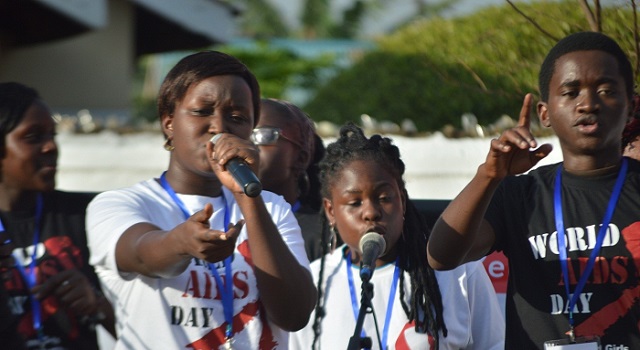
Museveni leads new campaign amidst new infections in middle-aged men, young girls
Kampala, Uganda | FLAVIA NASSAKA | Preliminary results of the 2016 Uganda Population HIV Impact Assessment (UPHIA) survey released in October confirmed something healthcare managers in the field of HIV/AIDS have feared for some time.
According to the survey, while HIV prevalence has generally reduced from 7.3% in 2011 to 6% today, it remains quite high among men aged between 45 and 49 years at 14%.
Dr. Nelson Musoba, the Ag. Director General at Uganda AIDs Commission says before the results were released, healthcare managers had realised that more adolescent girls and young women of 24 years and below were getting infected. They had their hunches about the source of the new infections among young women. After the survey they are now sure; the source of infection for the young girls is middle-aged men.
After confirming this, Musoba says, they realised that these men need to be told to go get tested and treated. And that is how Uganda decided to shift from the international theme for this year’s World AIDS Day, to a more relevant local one. They wanted the focus of discussion to be on the middle-aged men and young girls and women getting infected.
Moreover, up to 45% of the infected men according to the survey did not know their status and 48% of those who knew had not yet been enrolled on treatment. Also, it showed,that in 2016 alone, 14,348 men died of AIDS compared to 9,600 women.
December 01 has been World AIDs day since 1988. A global initiative aimed at raising awareness into a strange illness that initially baffled doctors has been swiftly changing to include other purposes such as weighing countries’ gains into tackling the epidemic in terms of research into prevention, treatment and the possibility of cure, and funding.
Every year has a theme. In 1988, the day was celebrated under the theme ‘Join the Worldwide Effort’ because then there was a need to mobilize and sensitize people across the globe about the virus that was considered to have been widespread only in certain regions of the world with Sub Saharan Africa considered the domain of the virus. With awareness, soon it was appreciated that the virus is spread across the globe. Then stakeholders started picking themes to represent significant periods in the struggle to tackle the epidemic. Musoba says themes are inspired by challenges faced and this year; while the UNAIDs international theme has been a ‘Right to Health’, Uganda has chosen to deviate to mark the day under the theme, ‘Reaching men, girls and young women to end HIV’.
To him, the biggest challenge for them this year has been getting more men to test and get enrolled on Anti-retroviral (ARV) treatment as soon as possible.
In Kole district where the main celebrations are being held, he says, a recently nationally launched campaign by President Yoweri Museveni – the Presidential Fast Track Initiative to end HIV in Uganda by 2030 will be re-launched. Musoba says the “initiative re-emphasizes issues like getting tested which are currently being viewed as basic with earlier gains which made the epidemic appear as if it is a problem solved”.
Up to 1.3million Ugandans are living with the virus. Even if this is a huge figure, more than half are enrolled on treatment. This means they are able to control the opportunistic effects of the disease and reduce further spread of the disease with consistent drug use.
Unfortunately this year has been particularly touching for the group that is enrolled on treatment. Even with full knowledge of what could happen to them if they keep skipping their daily doses; many missed their drugs because the government could not sustain them on treatment.
A few, according to Dr. Ian Clarke; a physician and proprietor of International Hospital Kampala, have decided to buy their own drugs. They do this silently, secretly because the government policy is that HIV drugs should not be sold anywhere by anyone in Uganda. But Clarke says there is nothing wrong with people buying the drugs.
“The only challenge is that there is a huge mass of people who cannot afford to buy ARVs and it is these who have been affected by drug shortages,” he says.
Clarke says drug stock outs are largely a government issue and are due to poor planning and poor funding as drug supplies cannot last all the way through the month even when they have committed to enroll everyone testing positive on treatment by adopting the World Health Organisation recommendations of test and treat.
Health Policy Analyst Dennis Odwe agrees with Clarke. He says HIV is one of the areas that receive the biggest donor funding but stock outs persist. For him, this shows lack of accountable leadership in the AIDS response. He says money meant to tackle the disease is sometimes diverted. For the country to make more gains, he says, political will should be heightened to address corruption as this will increase value for money spent in various activities in HIV.
Only on Nov.23 the country signed a new grant of $478million from Global Fund to among others fight HIV. This money expected to be used between 2018 and 2020 is part of the 93% donor funding of AIDS that the country gets annually. The fund contributes 28%, the US President’s Emergency Plan for AIDs Relief (PEPFAR) which is the biggest HIV funder contributes 62% and the government contributes only 7%. There is, however, still a funding gap of up to Shs.1.5trillion, according to health Minister Jane Ruth Aceng.
 The Independent Uganda: You get the Truth we Pay the Price
The Independent Uganda: You get the Truth we Pay the Price



I need a single pill cause I have been on treatment for 26years.but am still taking 6 pills a day.which affects mi a lot.and when I do search for the existence of one pill a day for victims who have been on drug for years its shown.but not in Uganda government hospitals.I need professionals to guide mi through this.Thanks
Good job Flavia on writing about Uganda Health issues. Keep it up.